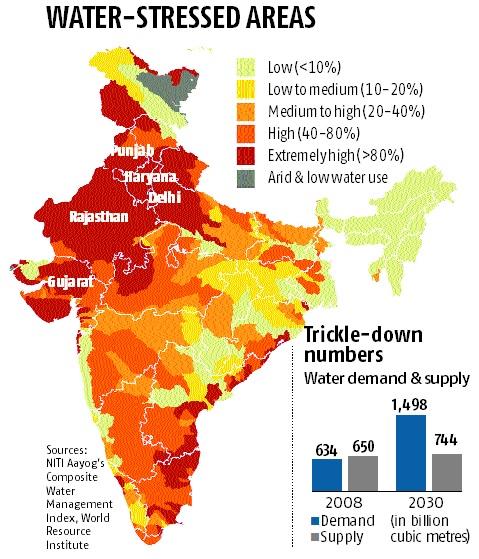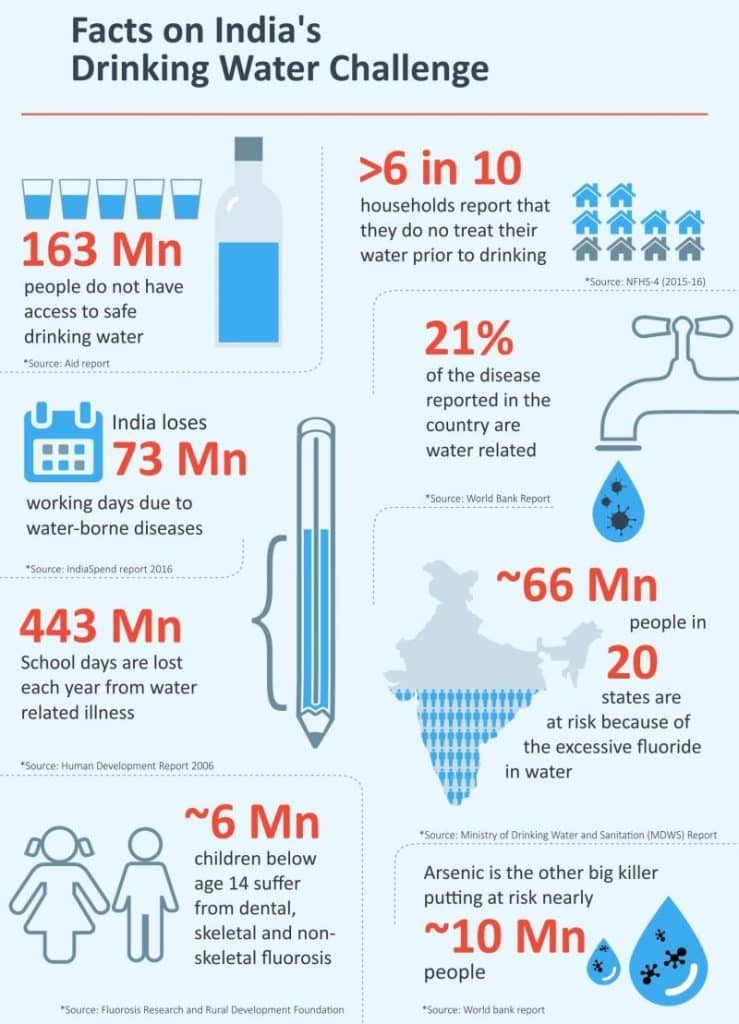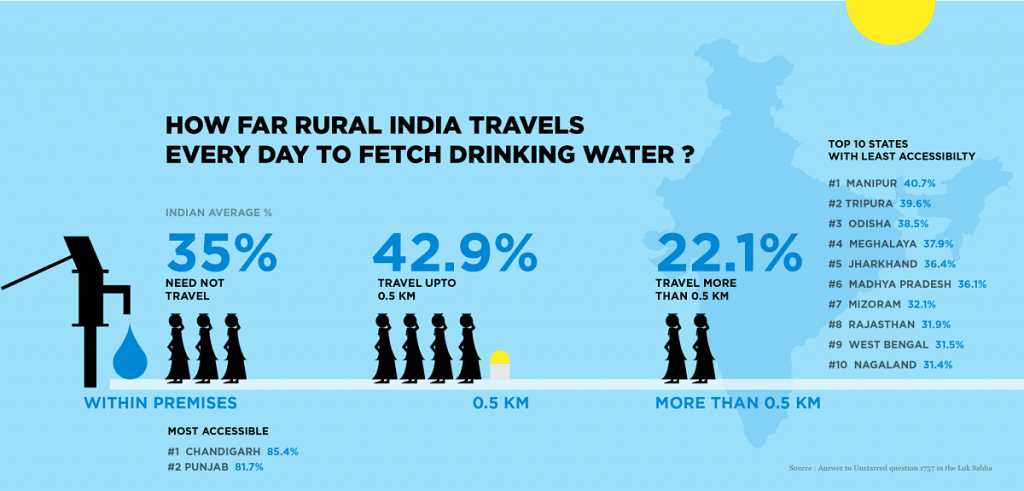In this article, You will read the Water Resources in India – for UPSC.
Water Resources
- Water resources are natural resources of water that are potentially useful as a source of water supply.
- 97% of the water on the Earth is salt water and only three percent is freshwater; slightly over two-thirds of this is frozen in glaciers and polar ice caps.
- The remaining unfrozen freshwater is found mainly as groundwater, with only a small fraction present above ground or in the air.
- Natural sources of freshwater include surface water, under river flow, groundwater, and frozen water. Artificial sources of freshwater can include treated wastewater (reclaimed water) and desalinated seawater.

India’s Water Resources
- Water resources in India includes information on precipitation, surface and groundwater storage and hydropower potential. India experiences an average precipitation of 1,170 millimetres (46 in) per year, or about 4,000 cubic kilometres (960 cu mi) of rains annually or about 1,720 cubic metres (61,000 cu ft) of fresh water per person every year.
- India accounts for 18% of the world’s population and about 4% of the world’s water resources.
- One of the solutions to solve the country’s water woes is to create Indian Rivers Inter-link.
- Some 80 percent of its area experiences rains of 750 millimetres (30 in) or more a year. However, this rain is not uniform in time or geography.
- Most of the rains occur during its monsoon seasons (June to September), with the northeast and north receiving far more rains than India’s west and south. Other than rains, the melting of snow over the Himalayas after the winter season feeds the northern rivers to varying degrees.
- The southern rivers, however, experience more flow variability over the year. For the Himalayan basin, this leads to flooding in some months and water scarcity in others.
- Despite extensive river system, safe clean drinking water, as well as irrigation water supplies for sustainable agriculture, are in shortage across India, in part because it has, as yet, harnessed a small fraction of its available and recoverable surface water resource.
- India harnessed 761 cubic kilometres (183 cu mi) (20 percent) of its water resources in 2010, part of which came from unsustainable use of groundwater.
- Of the water it withdrew from its rivers and groundwater wells, India dedicated about 688 cubic kilometres (165 cu mi) to irrigation, 56 cubic kilometres (13 cu mi) to municipal and drinking water applications and 17 cubic kilometres (4.1 cu mi) to industry.
Following findings of the report released by the National Sample Survey Office (NSSO) in August 2014:
- 54% of rural woman in India had to travel between 200 metres and 5 kilometres daily to fetch drinking water in 2012.
- They walked 20 minutes a day, on an average, and spend another 15 minutes at the source of water
- Every second woman has to spend 210 hours in a year for fetching water which means a loss of 27 days’ wages for these households. Collectively, these women cover 64,000 times the distance between the earth and the moon.
- Water crisis is imminent in villages because of over harvesting of ground-water resources. About 80% of the country’s drinking water needs are met by groundwater.
- 75% of the women in states like CJ, MN, OD, JH have to travel long distances for drinking water.
- India records world’s highest per capita water-borne diseases even more than some of the least developed nations.
- In most of the large cities about one-third of water never reaches the consumer because of leaks and poor maintenance. According to Centre for Science and Environment, over 35% of water in Delhi and about 30% in Mumbai is lost because of leakage.
Ground Water
- Annual utilizable ground water resources in India is assessed as 433 bcm.
- The main source of ground water is the recharge from monsoon precipitation. About 58% of countries annual rechargable ground water is contributed by monsoon rainfall. Other sources of recharge viz. seepage from canals, tanks, ponds and other water structures and irrigation account for about 32%.
- Among the states of India Uttar Pradesh has highest net annual ground water availability (~ 72 bcm) while Delhi has the least (0.29 bcm)(Central Ground Water Board, 2018 report).
- Countries with per-capita water availability less than 1700 m3 per year is categorized as water stressed, with per capita available water of 1545 m3 India is definitely water stressed country (India-WRIS wiki 2015, Census, 2011).
- The projected per capita water availability will become 1401 m3 and 1191 m3 by 2025 and 2050 respectively and eventually India is likely to become a water scarce country (India-WRIS, 2015).
- In India 85% of rural and other 50% of Urban water supplies depend upon groundwater for meeting drinking and domestic water needs.
- Central Ground Water Board noted that Punjab has only 20BCM of annual ground water availability, but extracts 35BCM and similarly Haryana extracts 13BCM while it’s availability is only 10BCM. consequently they fall under dark zones or higher ground water exploited areas.

Water Usage
- Irrigation by far is the largest user of India’s water reserve with hooping usage of 78% of total water reserve, followed by domestic sector (6%) and industrial sector (5%)(PIB 2013).
- National Commission on Integrated Water Resources Development (NCIWRD) the irrigation sector alone is going to need additional 71 bcm by 2025 and 250 bcm of water by 2050 compared to the demands of 2010 (Press Information Bureau 2013).
- Ground Water is also a major source of drinking water in urban and rural India. 45% of total irrigation and 80% of domestic water come from ground water reserve.
- States like DL, PN, HR, UP over exploitation of ground water has led to water scarcity. States like RJ, GJ arid climate leads to water stressed condition, while in TN, KA, AP poor aquifer properties are responsible for water scarcity. Other reasons being increasing population pressures, industrial growth and unprecedented pace of urbanization.
How safe is our water
- About 70% of surface water resources in India are polluted.
- The major contributing factor for water pollution are wastewater from different sources, intensive agriculture, industrial production, infrastructure development and untreated urban runoff .
- Everyday 2.9 billion liters of waste water from industrial and domestic sources are dumped into the river Ganga without treatment.
- According to WHO, Half of India’s morbidity is water related.
- Waste management has not been as efficient as required to manage increasing volume of waste generated daily in India, especially in cities. Municipal wastewater treatment capacity developed so far in India accounts for only 29% waste generated in urban habitations having population more than 50,000 and the gap is projected to increase.
- Domestic effluents contribute a substantial proportion of water pollution in India. More than 70% of domestic untreated effluents are disposed-off to environment.

The costs of unsafe water
- 2.2 billion people do not have access to clean water at home.
- 2.3 billion people lack access to basic sanitation services, such as toilets or latrines.
- Every day, more than 800 children under five years of age die from diarrhea caused by dirty water.
- 700 million people worldwide could be displaced by intense water scarcity by 2030.
The dilemma of Water Accessibility in Rural Areas
- More people in rural India have access to phones than to safe drinking water. It is estimated that only 18 percent of the total rural population of 833 million have access to treated water. In comparison, 41 percent of the rural population, or 346 million people, own mobile phones.(Forbes India, 2015).
- 30% of rural Indians lack drinking water supply (World Bank, UNICEF).
- According to National Sample Survey Office (NSSO), 57% of the rural women in India have to walk up to 5 km every day to fetch potable water as compared to just 21% in Urban areas.

Climate Change and its implications on water
- IPCC AR5 reports that mean annual temperature is increasing all over Asia and it is projected to increase >2oC till the end of 21st C. Rising temperature contributes to glacial melts resulting in glacier retreat and affecting the water availability in Himalayan rivers.
- Almost 67% of the glaciers in the Himalayan mountain ranges has retreated in the past decade due to warming effects.
Water Footprint
- When virtual footprints of different products were calculated, chocolate and leather had highest -24000 and 17000 litres per kg product. Followed by sheep(10400 lt), cotton(10000 lt), butter(5550 lt), chicken (4330 lt). Fruits and vegetables had least virtual water footprints.

In Groundwater section, Also mention about Physiographic Division of GW given by R.L.Singh.
What is meant by virtual footprints